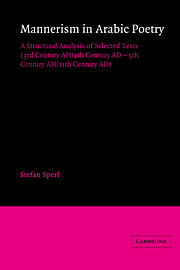 Mannerism in Arabic Poetry
Mannerism in Arabic Poetry 1 - The Islamic panegyric
Published online by Cambridge University Press: 17 November 2009
Summary
Much of the medieval Arabic poetic corpus consists of poems written in praise of rulers and notables of state. Some works of this type have been selected to provide examples of the literary styles with which this study is concerned. Before any stylistic analysis, however, it is advisable to consider in general terms the form and function of the panegyric mode in Arabic.
A remarkable feature of classical Arabic panegyric poems is that they do not only contain eulogy. The topic of praise usually appears last, preceded by a varied sequence of traditional themes which do not appear to relate to it directly. In a much cited passage, the medieval critic, Ibn Qutayba, described such a typical sequence of themes and attempted to explain its constitution. He mentioned dhikr al-diyār (henceforth referred to as alāl), nasīb, rahīl and madīh. The passage is quoted here again, since it gives perhaps the best – and certainly the most celebrated introduction to this peculiar and unique poetic form:
I have heard from a man of learning that the composer of Odes began by mentioning the deserted dwelling-places (atlāl) and the relics and traces of habitation. Then he wept and complained and addressed the desolate encampment, and begged his companion to make a halt, in order that he might have occasion to speak to those who had once lived there and afterwards departed; for the dwellers in tents were different from townsmen or villagers in respect of coming and going, because they moved from one water-spring to another, seeking pasture and searching out the places where rain had fallen.
- Type
- Chapter
- Information
- Mannerism in Arabic PoetryA Structural Analysis of Selected Texts (3rd Century AH/9th Century AD – 5th Century AH/11th Century AD), pp. 9 - 27Publisher: Cambridge University PressPrint publication year: 1989
